VW Beetle: Salt Lake Racer: Our shed
 Salt Lake Racer VW Beetle
Salt Lake Racer VW Beetle
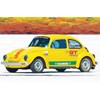
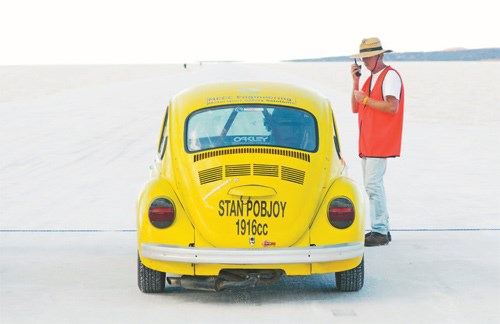 Salt Lake Racer VW Beetle
Salt Lake Racer VW Beetle

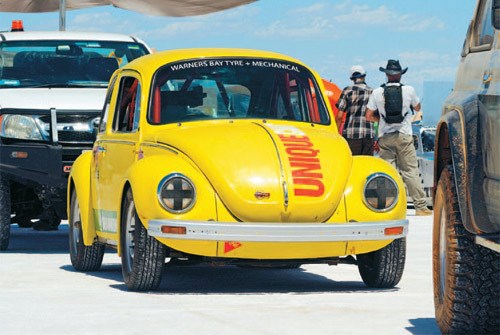 Salt Lake Racer VW Beetle
Salt Lake Racer VW Beetle

 Salt Lake Racer VW Beetle
Salt Lake Racer VW Beetle
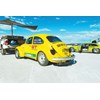
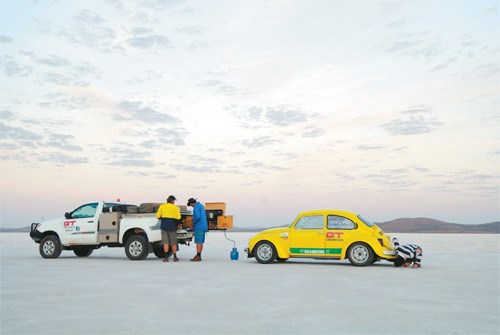 Salt Lake Racer VW Beetle
Salt Lake Racer VW Beetle

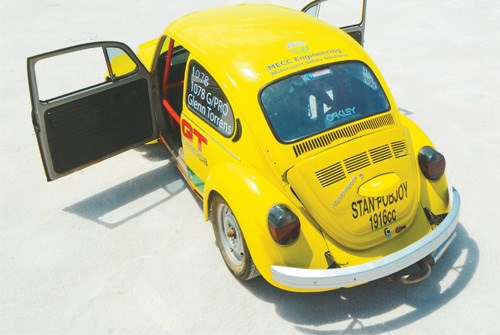 Salt Lake Racer VW Beetle
Salt Lake Racer VW Beetle

 Salt Lake Racer VW Beetle
Salt Lake Racer VW Beetle
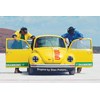
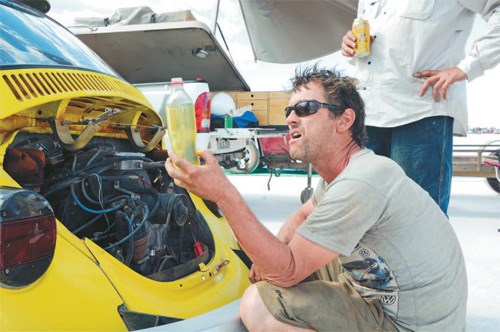 Salt Lake Racer VW Beetle
Salt Lake Racer VW Beetle

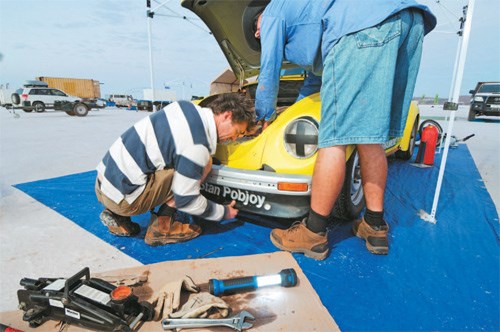 Salt Lake Racer VW Beetle
Salt Lake Racer VW Beetle

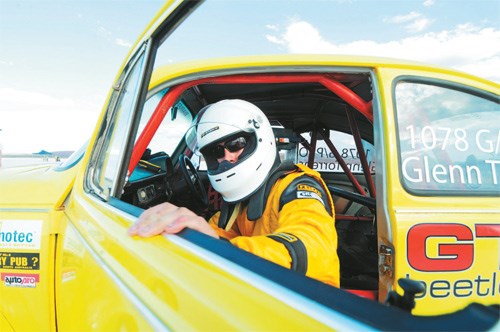 Salt Lake Racer VW Beetle
Salt Lake Racer VW Beetle


|
|
Salt Lake Racer VW Beetle
|

|
|
Salt Lake Racer VW Beetle
|

|
|
Salt Lake Racer VW Beetle
|

|
|
Salt Lake Racer VW Beetle
|

|
|
Salt Lake Racer VW Beetle
|

|
|
Salt Lake Racer VW Beetle
|

|
|
Salt Lake Racer VW Beetle
|

|
|
Salt Lake Racer VW Beetle
|

|
|
Salt Lake Racer VW Beetle
|

|
|
Salt Lake Racer VW Beetle
|
Glenn torrens shares the ups and downs of screwing together a Salt Lake racer

|
|
Salt Lake Racer VW Beetle
|
Salt Lake racer VW Beetle
After attending Australian Speed Week in outback South Australia for Unique Cars in 2010, I was keen to go back. Actually, I was determined to go back – and not just to stare.
I wanted to tackle the nutty challenge of going as fast as possible at one of the few places on Earth where you’re able to do so: On the hard-packed surface of a dry salt lake.
First thoughts were to take my existing ‘fast’ car, my bright yellow track VW Beetle that regular readers will recognise as a resident in Unique Cars’ shed.
But as I planned my speed a-salt (geddit?!) I discovered problems. Firstly, I built my hillclimb car to Australian CAMS regulations but the organising committee of Speed Week, the Dry Lake Racers Association, refers to US regulations that meant my car couldn’t easily meet the rules.
Plus, my hillclimb car is the old-style flat-’screen VW and I reckoned the later-model 1973-75 Super Beetle, with its rounded windscreen, would be better aerodynamically. And, to be honest with myself, I didn’t want my nice clean hillclimb car, developed over several years, racing in the dusty, corrosive environment of a salt lake. So I decided to build a salt lake racer!
SPINNING SPANNERS
I began with a bare Super Beetle body shell. Forlorn, faded and with its bum burnt by an engine bay fire, I’d swapped a VW engine for the body, intending to build a Euro-theme fast road Bug. Later, of course, the idea of building a salt car smacked me in the face – a second Super Beetle suffered a similar fate and donated its chassis to the salt lake project.
With the tatty body on the write-off’s chassis and with doors and suspension fitted, Salty (yes, it got a name) was trailered to a workshop in the ACT. Evan Vale is a mate-of-a-mate and when he’s not building guided missiles – or whatever it is that he does 9-to-5 – he builds roll cages under his MECC Engineering banner. He installed a six-point cage with tie-ins to the rear damper mounts, A- and B-pillars and the windscreen header rail, and plenty of cross-bracing.
After that, a few fatigue cracks were welded, dents were smoothed and after a weekend of priming and sanding, my mate Johnny volunteered to lay on a coat of bright yellow paint – the same colour as my hill climber.
With no need to go around corners, the chassis work was simple. A low ride height would help ease the breeze at speeds approaching – I was hoping – 200km/h. A set of height-adjustable front struts and a rear torsion bar tweak had Salty sitting low over relatively skinny 185/65 tyres on standard steelies. Other mechanical mods were limited to poly suspension bushes, screw-in wheel studs instead of VW’s silly original bolts, and a pared-down wiring harness to keep things simple.
The engine was an interesting challenge– for the wrong reasons. A bloke I used to know owed me a chunk of money and for years I’d had this cash earmarked for a high-performance VW engine I’d been lusting after for half my life. Despite years of promises, ol’ mate chose a solicitor over honour to weasel his way out of repayment.
I sacrificed the cash to Karma and ordered the engine anyway. After years of collecting parts – and waiting – starting and driving this engine for the first time, early in 2012, gave me a grin like a split watermelon!
It was bedded-in at a racetrack under my engine man’s watchful eye before I ventured home to spend a few weeks completing Salty’s final assembly and preparation. I also had to plan the tucker and supplies for a 10-day camping trek to Speed Week’s remote location half way across Australia. Then it rained.
Speed Week 2012 was cancelled.
A new date was announced (for May 2012) but it was thwarted by soggy salt, too. The event had been cancelled in 2011 for the same reason, ruining the plans and ambitions of around 300 participants. So Salty was pushed into a corner for the year. There was a silver lining in the dark cloud: I installed my ripper new engine into my hillclimb VW, gunning it hard at events such as the Australian Hillclimb Championships at Bathurst.
Salty again became the focus of my attention late last year when the real fun began. Finishing Salty meant making it comply with the DLRA’s sometimes ambiguous regulations. Thankfully, a pre-event scrutineering session gave me guidance to get Salty ready for the event’s official scrutineering with minimum fuss.
GETTING THERE
There’s a lot more to Speed Week than simply building the car. The event’s venue, Lake Gairdner, is at the end of a near-200km dirt track several hours north of the already out-of-the-way Iron Knob. Road conditions can vary – as is possible with any outback road – and the event’s isolation requires participants to bring their own supplies. My tow vehicle is a camperconverted Toyota HiLux and it lugged most of the tucker and water for ‘Team GT’: myself, fellow UC contributors Dave Morley and Guy Bowden and a mate from home, Nathan, plus a second engine and tools and equipment for the Beetle it towed.
I love outback travel and camping but when Nathan and I arrived after a two-and-a-half day steer via Dubbo, Broken Hill, Peterborough, Port Augusta and Iron Knob, we emerged from the HiLux’s air-conditioned comfort to debilitating 44-degree heat – stifling for camping and terrible for an air-cooled VW engine! Saturday afternoon and half of Sunday was spent doing as little as possible: swatting flies, sipping water and hoping for cooler conditions.
Thankfully, on Monday, race day, temps were a little more pleasant – mid-30s – as I prepared for my first ever run on the salt. Pulling on full Nomex underwear and suiting-up for the first time asn’t as bad as I expected – desert heat is dry, so it’s not as uncomfortable as tropical heat – but the closer the queue moved to the start line, the more nervous I became. By the time Morley and co had cinched down my harness, I was almost shitting myself.
But this was the moment I had been working toward for almost two years. Evenings, weekends – even plenty of days I should have been working – the cash, the fights, the doubts… it all seemed so overwhelming, yet somehow not matter, as everything crystallised in that serene moment the bloke on the start line gracefully pointed me to the great expanse of white.
Clutch out. Throttle down.
Racing on the salt doesn’t need adrag-race start but there’s no use dawdling around, either, so I wound out my little motor almost to its modest 5500rpm redline in first, then second. Surrounded by noise I was silent in my thoughts. Then … bleerrpp … Half way through third cog, the car hesitated as if someone had pulled up the handbrake. The engine still ran so I half-drove, half-coasted back to the pits where we discovered the fuel filter darkened by dust and rust. With that problem cleared, I went back out for a couple of 100mph runs.
After another lap Tuesday morning, it was obvious there was nothing more to be gained with my old street motor, the first of two motors I’d brought to the event. So we put the big one in! With an 8000rpm redline, big-valve heads and Weber carburettors, its speed potential above 100mph was anybody’s guess … as was the chance of the wing-shaped Beetle flying off the surface of the lake!
Sure, I was excited, but my nervousness had turned to confidence as I approached the start line again. My excitement and confidence turned to fist-clenching, air-punching elation as I saw ‘124mph’ come up on the GPS timing unit’s screen.
Two hundred kays an hour in a Beetle. Wow, what a ride!
AUSTRALIA'S FASTEST BEETLE?
With an official speed of 124.352mph (200.125km/h), my little yellow 1916cc ’74 Super Beetle became the fastest-ever Beetle to have campaigned at Australian Speed Week.
It’s also the second fastest air-cooled VW to have run at Lake Gairdner, eclipsed only by Steve Muller’s 2.3-litre Karmann Ghia speedster in 2010.
However, my mildly modded Bug doesn’t have as much cracker up its butt as Australia’s real fastest Beetle: Rod Penrose’s drag Bug demolishes the quarter mile in 8.96sec at 161mph (262km/h).
Another fast Aussie Beetle is Rudi Franks’ circuit car: His turbo Super Bug tops 240km/h on Sydney Motorsport Park’s pit straight.
*****
Search used:
>> Search Volkswagens for sale
Unique Cars magazine Value Guides
Sell your car for free right here
Get your monthly fix of news, reviews and stories on the greatest cars and minds in the automotive world.
Subscribe

.jpg)











